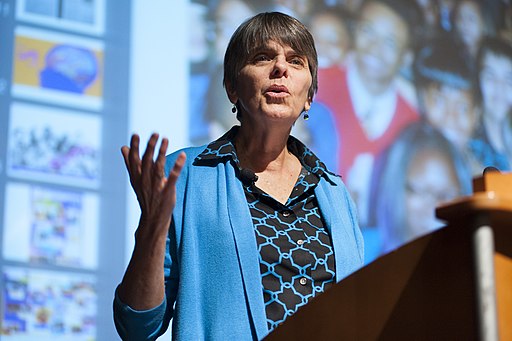Brandi Levy Cheers for Free Speech
The Supreme Court tackles student online First Amendment rights. What does it mean for schools and students?

Mary Beth Tinker in 2014 speaking at E.W. Scripps School of Journalism about student free speech to promote First Amendment rights for children.
June 30, 2021
Brandi Levy just got rejected from the varsity cheerleading team. She is angry, distraught, and disappointed. She makes a snapchat post. She and a friend pose, flipping off the camera. It reads “F*ck school, f*ck softball, f*ck cheerleading, f*ck everything.” It was a lash out against unfairness. It was typical teenage frustration. And it just happened to lead to a Supreme Court case.
A teammate of Levy brought the post to her coach. Levy received a suspension from the cheerleading team. The suspension was only for a year, but the message was clear.
Distraught by this apparent violation of his daughter’s First Amendment rights, Levy’s dad appealed to the school board to reverse the decision.
Across the country, schools have struggled for years with what they can and can’t regulate. During the past few decades, students have enjoyed a relatively unregulated virtual platform via the Internet and social media. Brandi Levy is arguing for the maintenance of First Amendment rights online, while her former school seeks to expand schools’ ability to regulate their students’ actions online.
This case is important because it could inform students and schools exactly what their rights are. Desiree Skrant, a junior at Hunterdon Central is eager to clearly know her rights online. “I would like to know where those lines are crossed,” she said.
This is not a new issue, however. In 1969, the Supreme Court ruled in the Tinker vs. Des Moines case that students do not “shed their constitutional rights to freedom of speech or expression at the schoolhouse gate.” There is an exception though: Schools do have the jurisdiction to violate a student’s First Amendment rights should their actions provide a “substantial” impact to the learning environment.
One example of this concept would be wearing a T-shirt with a controversial political stance emboldened across it. Mr. Brandt, Dean of Students at Hunterdon Central encounters this problem often. “You can’t shove it in somebody’s face, but you can wear it,” he said.
The question, though, is where does an impact from an online source, or off-campus, become substantial?
In the Levy case, the impact on the learning environment was simply that her friends were able to see the photo online, and it entered campus when a teammate brought it in. Is this impact “substantial” enough to warrant punishment?
Skrant has clear opinions on the issue. “It’s not taking place on campus so why should they have the right to involve themselves? It’s somebody else’s personal life,” she said. This is a common stance on the issue among students.
In Morse vs. Frederick, more notably known as the “Bong Hits For Jesus” case, the courts ruled differently from Tinker vs. Des Moines. Joseph Frederick, a high school student, held up a sign that read “Bong Hits 4 Jesus” at a high-school track meet.
In this case the courts ruled that the promotion of drug use was a substantial enough impact to warrant punishment.
It has always been difficult to determine though. Alicia D’Anella, a lawyer for Comegno Law Group PC, who specializes in education law, is hopeful of added clarity to the current situation. “This would be a great time to clarify where those lines are,” she said.
The Brandi Levy case could change everything.
Levy makes the case that outside school, student’s actions are none of the school’s business. Her former school counters that in this day and age, schooling is so much online that the school’s jurisdiction should extend to online actions.
As the years go on, and technology integrates itself more and more into our lives, the line between where schools do and don’t have jurisdiction to regulate their students blurs. “There’s a lot of grey area,” said Mr. Brandt.
Levy has already won two cases on the issue, but there is less certainty about the way that the Supreme Court will react. This is one of the first large-scale cases being heard by the courts since the addition of justices Kavanaugh, Gorsuch, and Barrett. “This is a court that could be potentially willing to restrict speech in the name of law and order,” D’Anella said.
So there lies the question. How will the Supreme Court react? Will students have online activity relatively unchecked by schools? Will students need to consider school before they act outside of school? Or will there be no additional clarity at all?
This is a necessary decision though. Mr. Brandt says that “just about every school in the country is watching this one.” Schools have gone a long time pushing through with unclear guidelines, and constant deliberation. The Supreme Court will likely release its ruling at the end of the term, in late June or early July, and none too soon, as we could all use a little clarity.
Editor’s Note: After this article was published the Supreme Court ruled in favor of Brandi Levy in an 8-1 decision. To learn more about the B.L v Mahanoy Area School District v B.L. decision and what it means for students’ rights click here.